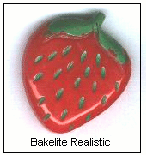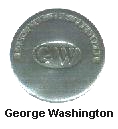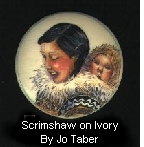

| You see them every day. They fasten your shirt together, hold your pants up, and maybe make a fashion statement on your new sweater. Buttons! Almost everyone has some buttons stashed away in a box or jar. They can be plain and simple, or truly elegant works of art. Due to our natural hoarding instincts, buttons find their way into nooks and crannies in our homes. It is time for them to step up and take their rightful place as a popular collectible. |
|
Buttons have been in use for hundreds of years. In very early times, clothing was fastened with ties or pins, but gradually toggles and buttons as we know them came to be in use. Many ancient burials have included buttons or button-like objects. In the Early and Middle Bronze Age, large buttons were primarily used to fasten cloaks. By the 13th century, buttons were widely in use, mainly as decoration. As most clothing of that time period was closed with lacing or hooks, garments didn't use buttons as methods of closing on a regular basis until the last half of the 16th century. Most of the buttons from this time period were small, but over the next century or so they became larger and very ornate, often using precious metals and jewels. During the 17th and 18th Century, most buttons were worn by men. |
 |
By the 18th century, buttons were becoming larger, and had even more elaborate designs. Buttons continued to make a fashion statement and the button-making industry hit such a high standard that the period from 1830-1850 has become known as the Golden Age. As mass production techniques progressed, and new synthetic materials were developed, the general standard declined. From 1860 on, women have been the main consumers of "novelty" buttons. A button is officially an object that can be used to fasten garments, with either a shank (usually a loop) on the back used to sew the button to the clothing, or with holes in the center to allow thread to pass through the body of the button. |
|
Buttons have been made from almost every material found in nature or created by man. Metals are one of the most popular materials, including everything from iron to gold. Another popular material used in button making is mother of pearl, or shell of any kind. Bone, ivory, cloth, glass, stone, cinnabar, horn, antler, leather, papiér maché, ceramic, celluloid, Bakelite, and wood, plus any combination of these, have been used to fashion these miniature works of art. |
 |
| One of the most interesting and misrepresented materials used in buttons is jet. This is a naturally occurring mineral, with a carbon base. It is lightweight and fragile, so surviving examples are very hard to come by. Queen Victoria started a fashion in 1861 by wearing black jet buttons to mourn the death of her husband Albert. Since jet was such a rare and expensive mineral, black glass came to be substituted by the rest of the population for their mourning attire. Consequently, black glass buttons are still very common today, but are often mislabeled as "jet" buttons. Adding to the confusion were a number of companies that made black glass buttons and marketed them as "French Jet." One way to test whether that black button you found is jet or glass is by giving it the floating test. Glass buttons will sink to the bottom in a glass of water, but the lightweight jet buttons will float. |
|
Throughout the years, the decorations on buttons have reflected both the fashion and passions of the time. Nearly everything has been pictured on a button. Animals are one of the most popular subjects, along with plant life and objects like belt buckles and hats. Some buttons are shaped like the item they portray, and are known as "realistics" for their realistic appearance. Others simply had the design engraved, stamped, painted or enameled on the surface of a conventionally shaped button. Many of the antique buttons feature very detailed paintings in miniature. |
 |
 |
A rare and very unusual type of button is called a "habitat." These have a metal back, with a dome shaped glass cap. But what makes them special is what is UNDER the glass. These buttons include dried plant and animal material, usually arranged to create a natural looking scene. Sometimes whole insects were used. Because of their age, and lack of preservation techniques used in the past, these buttons are rarely seen, and often in poor condition. A good quality habitat button will often sell for several hundred dollars. |
| People and their many activities is another popular subject. Architectural objects like buildings, bridges and monuments also decorated many buttons. Political candidates, opera stars, and fairy tales are richly represented, and are favorites with collectors. Some buttons even portray risqué subjects. Buttons produced for George Washington's inauguration are some of the most sought-after buttons in the United States. |  |
| Uniform buttons fall into a special category all their own. Most of us automatically think of the military when we think of uniforms, but there are an amazing variety of uniforms in our society. Both Police and Fire Departments have their own buttons, often with the name of the city stamped on the front. Bus lines, airlines, shipping lines, city or state employees, hotels, railroads, banks, and even schools have their own unique buttons. A related field is Livery buttons. These buttons were worn by servants in large households, usually in England, and had the family's coat of arms or crest on it. |
| There are many collectibles related to buttons. It is not unusual to find a button collector that also hunts out belt buckles, cuff links and studs, buttonhooks, netsuke, or bridle rosettes. These are another way to add variety to your collection. |
| One advantage button collecting has over many other collectibles is that many of them are very reasonably priced. They can range in price from a few cents for a handful of common bone or shell buttons to thousands of dollars for a prime antique specimen. A French enamel button featuring a hot air balloon scene recently sold at auction for approximately $850. There are still many beautiful and intriguing examples of buttons available anywhere from $2 to $30. |
| Collectors in the United States formed a nationwide club in 1938. This club is called the National Button Society, or NBS. This group offers collectors a chance to learn more about their hobby. The NBS is also responsible for setting up and organizing rules for button competitions. Each year a special National show is held in a different location, where collectors gather from all over the world to attend seminars, compete with others on a national basis,and meet old and new friends who share a passion for buttons. There are many local and state clubs that also offer competitions and a chance for both the new and experienced collector to learn more. |  |
| Everyone has used buttons. Look through a button box and see if there is a polished pearl or glossy glass button hiding there. You may find you want to know more about them. But, I warn you, button collecting is addictive! |
| For More Information on the NBS, please write:
The National Button Society Miss Lois Pool 2733 Juno Place Akron, Ohio 44333-4137 Bibliography and suggested reading: The Big Book of Buttons
Buttons: The Collector's Guide to Selecting, Restoring, and Enjoying
New and Vintage Buttons
The Collector's Encyclopedia of Buttons
Record of American Uniform and Historical Buttons, Bicentennial Edition
Don't forget to check your local library for more books on buttons and button collecting. Buttons provided by the author, Tina McDaniel and Sonja Medcalf
|
